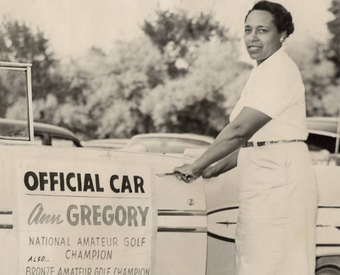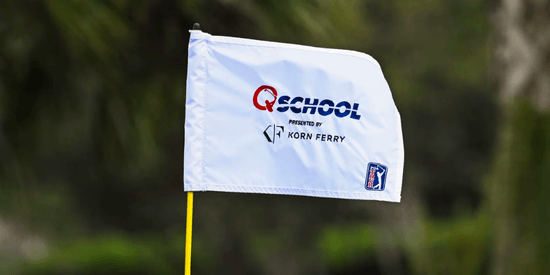The Natural: Ann Gregory
2/12/2022 | by United States Golf Association

Ann Gregory was the first African-American to play in the U.S. Women's Amateur. On the course, she let her clubs do the talking.
In celebration of Black History Month, we're happy to share some of the stories of African-Americans who have played a significant role in the growth of golf, both on and off the course. With the permission of the USGA, we take a look back at Peter F. Stephens wonderful profile of Ann Gregory, the first African-American to play in the U.S. Women's Amateur. This story first appeared in the September 1998 issue of Golf Journal magazine.
* * * * *
Carolyn Cudone has never forgotten her first-round match in the 1956 U.S. Women's Amateur Championship – and with good reason. For regardless of the outcome, history would be written that morning of Sept. 17 at Meridian Hills Country Club in Indianapolis, Ind.
“There was a mob at the first tee,” Mrs. Cudone recalls. “A lot of them were reporters. I was shocked by the crowd's size because in those days, first-round matches didn't often draw so many people.”
But as most writers noted, no match in the United States Women's Amateur had ever before included the Negro Women's Golf Association champion. Today, more than four decades later, Cudone vividly remembers the words of a club parking attendant to her father before the match: “Your daughter better win today or you'd better not come back to this parking lot.”
“I had no idea what to expect,” she recalls. “I'd never even seen Ann Gregory play.”
Gregory’s very appearance in the championship was a milestone, but she had another reason for having entered. She loved the game and she loved competition. Alice Dye, who also was a competitor in that Women's Amateur, remembers simply, “Ann was there to play golf.”
Thurgood Marshall’s milestone Supreme Court decision in Brown vs. the Board of Education of Topeka, which desegregated public schools, was less than three years old when Gregory walked onto the course at Meridian Hills. Just eight months earlier, a federal court had ordered Nashville, Tenn.’s public golf courses opened to African Americans; however, in Greensboro, N.C., a jury convicted six African Americans of trespassing for having played on a public course.
In the nation's racially charged social climate, the hatred of many and the hopes of others swirled about Gregory.
Born Ann Moore in Aberdeen, Miss., on July 25, 1912, she was only 4 when her mother and father were killed in a car crash. Her parents’ former employers, a white family named Sanders, took in the orphan and would provide her room and board over the following years in exchange for her working as a maid’s helper and later a maid.
At 26, she married Percy Gregory and moved north to Gary, Ind., where her husband took a good job with United States Steel. In The Illustrated History of Women’s Golf, written by Rhonda Glenn, Gregory recalled how the Sanders had reacted: “[They] cried like babies. They said people in the north were so cold and that I didn’t deserve being treated like that. I said, ‘Mrs. Sanders, you've prepared me very well for mistreatment.’”
Gregory soon became a well-known and well-liked figure in her new community, helping to cater functions at local colleges and volunteering on church committees and civic charity drives. Further testifying to her growing popularity and profile in the city was her appointment as the first African American on Gary’s formerly all-white public library board. In addition to work, family and civic functions, Gregory, a natural athlete in her teens, somehow found time to learn tennis. She built a powerful serve-and-volley game that won her the Gary City Championship. In 1943, she took up golf, joining the nearby Chicago Women's Golf Association, an all-black organization that played at several regional public courses.
Gregory, who had never swung a club, took lessons from Calvin Ingram, a fine player and a veteran of the United Golfers Association, the black golf circuit, and discovered that she possessed a natural touch from tee to green. In just three years, Gregory crafted a top-notch game – an impressive accomplishment for someone who had not played golf until her early 30s.

Ann Gregory
So steadily did she develop her game that by 1947, having won the Chicago Women's Golf Association Championship, the Joe Louis Invitational and the United Golf Association Championship, the black press dubbed her the “Queen of Negro Women’s Golf.” Gregory's first chance to pit her game against outstanding white amateurs came in September 1947, when mercantile mogul and golf lover George May invited her to compete at the Tam O’Shanter Country Club in Chicago in his All-American Open. Gregory accepted, later telling Glenn in an interview: “Mr. May told me if anyone said anything to me [at the tournament] to let him know.”
Gregory went on to note that “the galleries were just beautiful to me” and that “my neighbors drove up from Gary to see me play the final round. When I saw them, that’s the only time I felt funny. It just did something to me to see my black friends among all those white people, and I cried.”
The support of family and friends notwithstanding, Gregory learned at the All-American Open that her game wasn’t up to the standards of the more experienced white golfers. Any moral victory gained simply by playing in the event was not enough for Gregory. Now that she had seen the white players’ games up close, she was more determined than ever to compete with them.
Her chance finally came at the 1956 U.S. Women's Amateur at Meridian Hills Country Club. As Gregory and Cudone walked past the large gallery to Meridian’s No. 1 tee to play their first-round matchup, history unfolded, but not everyone, as reflected by the parking attendant’s rejoinder to Cudone’s father, welcomed Gregory’s milestone.
Cudone remembers that she and Gregory were both nervous. “I teed off first,” she said, “and got off a good shot that got a big cheer from the crowd. Ann’s shot went at least 20 yards longer than mine but got only a tiny cheer.”
As the women played the front nine, Gregory shaped several brilliant recoveries and managed to gain the lead. Cudone played solidly and waited for an opening. “By the end of the front nine,” she recalls,
“I knew that Ann was really good. Her game was scaring me to death. Her shots were so long. Ann came closer to more holes-in-one than just about anyone I can remember. It always seemed she was knocking it 3 feet from the cup.”
On the back nine, as Gregory forged a 2-up lead, it appeared the newspaper headlines she’d make would be not for merely competing in the Women’s Amateur, but for winning a match in her first try.
Cudone remained in the hunt, however, and when Gregory began to spray her tee shots over the final few holes, Cudone stormed back and captured the match, 2 and 1.
“When we shook hands,” Cudone recalled, “do you know what Ann told me? She said: ‘My husband said I didn't have a snowball’s chance in hell. I guess I fooled him.’
“Ann was so nice, so gracious,” Cudone continued. “Our match was the start of a real rivalry, but a really friendly and fun one.” In 1971 Cudone edged Gregory by one stroke at Sea Island Golf Club in St. Simons Island, Ga., to claim the fourth of her five consecutive U.S. Senior Women’s Amateur titles.
By the time Gregory entered the 1959 U.S. Women’s Amateur at Congressional Country Club in Bethesda, Md., she had proved without question that she had more than “a snowball’s chance” of beating her opponents. But that did not mean she would find greater acceptance from players or clubs.
Already embroiled in criticism from the black press because she had opted for the Women’s Amateur instead of an all-black tournament in Washington, D.C., Gregory was not invited by Congressional to the Amateur’s traditional pre-tournament dinner.
In an interview with Glenn some 20 years later, Gregory said: “I told [USGA Executive Director] Joe Dey it was no big deal. I said, ‘I realize the money I paid to enter the tournament didn’t buy stock in the clubhouse. I’ll eat a hamburger and be just as happy as a lark, waiting on tee number one.’ ... I just wanted to play golf.”
Over the next two days, Gregory did just that. She defeated her opening-round opponent, Mrs. Thaddeus Owings, in a grueling match and was pitted against the Georgia State champion, Mrs. Curtis Jordan, in the second round. Jordan took the lead on the first hole and late in the match held a solid 2-up advantage. Deep into the back nine, Gregory made a charge and knotted the match at the 17th. At the closing hole, Gregory coolly cracked her 3-iron across the water and onto the green. Jordan flew her ball into a deep bunker and ended up making bogey. Gregory knew that a two-putt would win the match.
“I stroked my putt, turned my head away, and heard the ball fall into the cup,” she would tell Glenn. “All of the people began to applaud, for once. When I made that deuce to win, my caddie turned a somersault. The club fired him for that.”
In the third round, Gregory was eliminated by Diana Hoke, 6 and 4, but as Canadian great Marlene Stewart Streit remembered, Gregory had proved yet again that “she could really play the game.” Glenn wrote that Gregory was invited by Congressional’s president to play the course anytime she wanted, but declined the offer.
In Tulsa, Okla., for the 1960 Women’s Amateur, Gregory again refused to let racism cow her. This time, it was a white hotel manager who refused to honor her reservation and compelled the Gregorys to stay at a blacks-only hotel with no air conditioning. Ann and Percy did their best to battle the heat by sitting on the hotel’s steps and eating ice cream for much of the night.
Having shown that she could compete with white female golfers, many on their way to fame in the professional ranks, Gregory went on to make perhaps her strongest civil-rights point of all in the early 1960s. In Gary, the best public course was Gleason Park, which sported a groomed 18-hole layout for whites and a ragged nine-hole course for African Americans. Toting her clubs, Gregory strolled into the course’s clubhouse one summer morning and paid the white course’s green fee to a startled clerk.
“My tax dollars are taking care of the big course,” she reportedly said, “and there’s no way you can bar me from it. Just send the police out to get me.”
They never came.
* * * * *
Carolyn Cudone has never forgotten her first-round match in the 1956 U.S. Women's Amateur Championship – and with good reason. For regardless of the outcome, history would be written that morning of Sept. 17 at Meridian Hills Country Club in Indianapolis, Ind.
“There was a mob at the first tee,” Mrs. Cudone recalls. “A lot of them were reporters. I was shocked by the crowd's size because in those days, first-round matches didn't often draw so many people.”
“I had no idea what to expect,” she recalls. “I'd never even seen Ann Gregory play.”
Gregory’s very appearance in the championship was a milestone, but she had another reason for having entered. She loved the game and she loved competition. Alice Dye, who also was a competitor in that Women's Amateur, remembers simply, “Ann was there to play golf.”
Thurgood Marshall’s milestone Supreme Court decision in Brown vs. the Board of Education of Topeka, which desegregated public schools, was less than three years old when Gregory walked onto the course at Meridian Hills. Just eight months earlier, a federal court had ordered Nashville, Tenn.’s public golf courses opened to African Americans; however, in Greensboro, N.C., a jury convicted six African Americans of trespassing for having played on a public course.
In the nation's racially charged social climate, the hatred of many and the hopes of others swirled about Gregory.
Born Ann Moore in Aberdeen, Miss., on July 25, 1912, she was only 4 when her mother and father were killed in a car crash. Her parents’ former employers, a white family named Sanders, took in the orphan and would provide her room and board over the following years in exchange for her working as a maid’s helper and later a maid.
At 26, she married Percy Gregory and moved north to Gary, Ind., where her husband took a good job with United States Steel. In The Illustrated History of Women’s Golf, written by Rhonda Glenn, Gregory recalled how the Sanders had reacted: “[They] cried like babies. They said people in the north were so cold and that I didn’t deserve being treated like that. I said, ‘Mrs. Sanders, you've prepared me very well for mistreatment.’”
Gregory soon became a well-known and well-liked figure in her new community, helping to cater functions at local colleges and volunteering on church committees and civic charity drives. Further testifying to her growing popularity and profile in the city was her appointment as the first African American on Gary’s formerly all-white public library board. In addition to work, family and civic functions, Gregory, a natural athlete in her teens, somehow found time to learn tennis. She built a powerful serve-and-volley game that won her the Gary City Championship. In 1943, she took up golf, joining the nearby Chicago Women's Golf Association, an all-black organization that played at several regional public courses.
Gregory, who had never swung a club, took lessons from Calvin Ingram, a fine player and a veteran of the United Golfers Association, the black golf circuit, and discovered that she possessed a natural touch from tee to green. In just three years, Gregory crafted a top-notch game – an impressive accomplishment for someone who had not played golf until her early 30s.

Ann Gregory
Gregory went on to note that “the galleries were just beautiful to me” and that “my neighbors drove up from Gary to see me play the final round. When I saw them, that’s the only time I felt funny. It just did something to me to see my black friends among all those white people, and I cried.”
The support of family and friends notwithstanding, Gregory learned at the All-American Open that her game wasn’t up to the standards of the more experienced white golfers. Any moral victory gained simply by playing in the event was not enough for Gregory. Now that she had seen the white players’ games up close, she was more determined than ever to compete with them.
Her chance finally came at the 1956 U.S. Women's Amateur at Meridian Hills Country Club. As Gregory and Cudone walked past the large gallery to Meridian’s No. 1 tee to play their first-round matchup, history unfolded, but not everyone, as reflected by the parking attendant’s rejoinder to Cudone’s father, welcomed Gregory’s milestone.
Cudone remembers that she and Gregory were both nervous. “I teed off first,” she said, “and got off a good shot that got a big cheer from the crowd. Ann’s shot went at least 20 yards longer than mine but got only a tiny cheer.”
As the women played the front nine, Gregory shaped several brilliant recoveries and managed to gain the lead. Cudone played solidly and waited for an opening. “By the end of the front nine,” she recalls,
“I knew that Ann was really good. Her game was scaring me to death. Her shots were so long. Ann came closer to more holes-in-one than just about anyone I can remember. It always seemed she was knocking it 3 feet from the cup.”
On the back nine, as Gregory forged a 2-up lead, it appeared the newspaper headlines she’d make would be not for merely competing in the Women’s Amateur, but for winning a match in her first try.
Cudone remained in the hunt, however, and when Gregory began to spray her tee shots over the final few holes, Cudone stormed back and captured the match, 2 and 1.
“When we shook hands,” Cudone recalled, “do you know what Ann told me? She said: ‘My husband said I didn't have a snowball’s chance in hell. I guess I fooled him.’
“Ann was so nice, so gracious,” Cudone continued. “Our match was the start of a real rivalry, but a really friendly and fun one.” In 1971 Cudone edged Gregory by one stroke at Sea Island Golf Club in St. Simons Island, Ga., to claim the fourth of her five consecutive U.S. Senior Women’s Amateur titles.
By the time Gregory entered the 1959 U.S. Women’s Amateur at Congressional Country Club in Bethesda, Md., she had proved without question that she had more than “a snowball’s chance” of beating her opponents. But that did not mean she would find greater acceptance from players or clubs.
Already embroiled in criticism from the black press because she had opted for the Women’s Amateur instead of an all-black tournament in Washington, D.C., Gregory was not invited by Congressional to the Amateur’s traditional pre-tournament dinner.
In an interview with Glenn some 20 years later, Gregory said: “I told [USGA Executive Director] Joe Dey it was no big deal. I said, ‘I realize the money I paid to enter the tournament didn’t buy stock in the clubhouse. I’ll eat a hamburger and be just as happy as a lark, waiting on tee number one.’ ... I just wanted to play golf.”
Over the next two days, Gregory did just that. She defeated her opening-round opponent, Mrs. Thaddeus Owings, in a grueling match and was pitted against the Georgia State champion, Mrs. Curtis Jordan, in the second round. Jordan took the lead on the first hole and late in the match held a solid 2-up advantage. Deep into the back nine, Gregory made a charge and knotted the match at the 17th. At the closing hole, Gregory coolly cracked her 3-iron across the water and onto the green. Jordan flew her ball into a deep bunker and ended up making bogey. Gregory knew that a two-putt would win the match.
“I stroked my putt, turned my head away, and heard the ball fall into the cup,” she would tell Glenn. “All of the people began to applaud, for once. When I made that deuce to win, my caddie turned a somersault. The club fired him for that.”
In the third round, Gregory was eliminated by Diana Hoke, 6 and 4, but as Canadian great Marlene Stewart Streit remembered, Gregory had proved yet again that “she could really play the game.” Glenn wrote that Gregory was invited by Congressional’s president to play the course anytime she wanted, but declined the offer.
In Tulsa, Okla., for the 1960 Women’s Amateur, Gregory again refused to let racism cow her. This time, it was a white hotel manager who refused to honor her reservation and compelled the Gregorys to stay at a blacks-only hotel with no air conditioning. Ann and Percy did their best to battle the heat by sitting on the hotel’s steps and eating ice cream for much of the night.
Having shown that she could compete with white female golfers, many on their way to fame in the professional ranks, Gregory went on to make perhaps her strongest civil-rights point of all in the early 1960s. In Gary, the best public course was Gleason Park, which sported a groomed 18-hole layout for whites and a ragged nine-hole course for African Americans. Toting her clubs, Gregory strolled into the course’s clubhouse one summer morning and paid the white course’s green fee to a startled clerk.
“My tax dollars are taking care of the big course,” she reportedly said, “and there’s no way you can bar me from it. Just send the police out to get me.”
They never came.
Most Popular Articles

2025 PGA TOUR Q-School Guide: Sites, Scores, and Who Advanced
Dec 5, 2025Second Stage is complete and Final Stage awaits at Sawgrass — follow every Q-School leaderboard and the players still chasing
2025 LPGA TOUR Q-Series: Final Qualifying Stage FINAL SCORING
Dec 8, 2025Helen Briem earns medalist honors, 31 players headed to the LPGA next year
2025 PGA TOUR Q-School Final Stage: Ewart Leads Five New TOUR Card Winners
Dec 14, 2025A.J. Ewart topped Final Stage at TPC Sawgrass, leading five players who secured PGA TOUR membership for 2026.
Australian Open at Royal Melbourne: Preview, amateur bios, and how to watch
Nov 30, 2025Rory McIlroy headlines one of the championship's top fields in years - at least four amateurs will have their chance at gloryInside Gil Hanse’s Restoration of Baltusrol’s Upper Course: A Return to Tillinghast’s
Dec 11, 2025Renowned architect Gil Hanse reveals how he brought Baltusrol’s Upper Course back to life by honoring A.W. Tillinghast’s originalLoading latest news...
